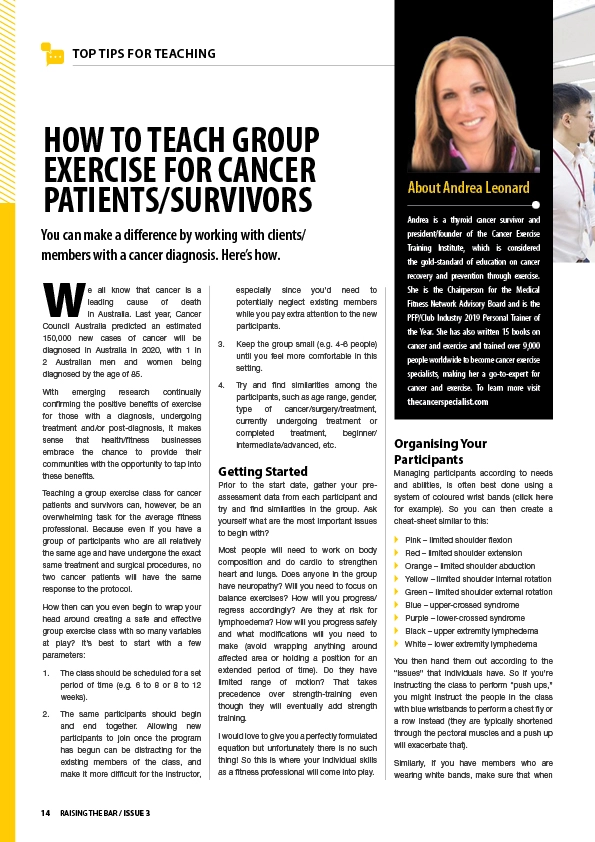top tips for TEACHING
How To Teach Group Exercise For Cancer Patients/Survivors

We all know that cancer is a leading cause of death in Australia. Last year, Cancer Council Australia predicted an estimated 150,000 new cases of cancer will be diagnosed in Australia in 2020, with 1 in 2 Australian men and women being diagnosed by the age of 85.
With emerging research continually confirming the positive benefits of exercise for those with a diagnosis, undergoing treatment and/or post-diagnosis, it makes sense that health/fitness businesses embrace the chance to provide their communities with the opportunity to tap into these benefits.
Teaching a group exercise class for cancer patients and survivors can, however, be an overwhelming task for the average fitness professional. Because even if you have a group of participants who are all relatively the same age and have undergone the exact same treatment and surgical procedures, no two cancer patients will have the same response to the protocol.
How then can you even begin to wrap your head around creating a safe and effective group exercise class with so many variables at play? It’s best to start with a few parameters:
The class should be scheduled for a set period of time (e.g. 6 to 8 or 8 to 12 weeks).
The same participants should begin and end together. Allowing new participants to join once the program has begun can be distracting for the existing members of the class, and make it more difficult for the instructor, especially since you’d need to potentially neglect existing members while you pay extra attention to the new participants.
Keep the group small (e.g. 4-6 people) until you feel more comfortable in this setting.
Try and find similarities among the participants, such as age range, gender, type of cancer/surgery/treatment, currently undergoing treatment or completed treatment, beginner/intermediate/advanced, etc.
Getting Started
Prior to the start date, gather your pre-assessment data from each participant and try and find similarities in the group. Ask yourself what are the most important issues to begin with?
Most people will need to work on body composition and do cardio to strengthen heart and lungs. Does anyone in the group have neuropathy? Will you need to focus on balance exercises? How will you progress/regress accordingly? Are they at risk for lymphoedema? How will you progress safely and what modifications will you need to make (avoid wrapping anything around affected area or holding a position for an extended period of time). Do they have limited range of motion? That takes precedence over strength-training even though they will eventually add strength training.
I would love to give you a perfectly formulated equation but unfortunately there is no such thing! So this is where your individual skills as a fitness professional will come into play.
Organising Your Participants
Managing participants according to needs and abilities, is often best done using a system of coloured wrist bands (click here for example). So you can then create a cheat-sheet similar to this:
Pink – limited shoulder flexion
Red – limited shoulder extension
Orange – limited shoulder abduction
Yellow – limited shoulder internal rotation
Green – limited shoulder external rotation
Blue – upper-crossed syndrome
Purple – lower-crossed syndrome
Black – upper extremity lymphedema
White – lower extremity lymphedema
You then hand them out according to the “issues” that individuals have. So if you’re instructing the class to perform “push ups,” you might instruct the people in the class with blue wristbands to perform a chest fly or a row instead (they are typically shortened through the pectoral muscles and a push up will exacerbate that).
Similarly, if you have members who are wearing white bands, make sure that when you have the class perform lower body exercises that they start and progress slowly with both weight and repetitions and monitor for swelling in their lower body over the next 24 to 28 hours.
If you have someone with a green wrist band, you can instruct them to work on range of motion in anything requiring external rotation (refrain from using resistance until they achieve 90% of the lowest norm).
The system can be a great way to help you monitor participants, especially given that you cannot possibly remember everyone’s individual assessment results!
Equipment
I like to use a step as a workout bench/home-base. I then have participants select some light hand-weights, bands, weighted balls, or whatever is available, and carefully place them near their bench.
Each class starts with 10 to 15 minutes of cardio. If this is a beginner class and/or the participants are undergoing treatment and functioning at a lower level, consider cutting the class back to half an hour instead of the standard one-hour class duration, and be sure to modify the timing accordingly. For a deconditioned or lower-functioning class, consider progressing from marching in place with/without raising arms above head to a standing cardiovascular component.
Keep in mind that people will progress at different rates than others. It is critical, therefore, to set realistic goals for each individual in the class to ensure their success. Always encourage everyone to work at their own level and praise them for even the smallest of improvements and accomplishments.
If you are teaching yoga or Pilates, you can modify the various exercises and poses accordingly. For example, if participants have limited shoulder range of motion, a yoga pose should be fluid in motion rather than held for a period of time. This will encourage increased range of motion rather than isometric strength from holding a position. Remember that range of motion should be 90% or better, of the lowest range of motion norms in a particular plane of motion, prior to adding resistance of any kind (this includes holding a pose).
Typically, I alternate upper and lower body exercises and have participants do stretches or balance exercises in between. It’s also a great idea to include some neuro-training as well. This could be counting backwards, opening/closing eyes or switching planes/directions.
At the end of class you can cool down by incorporating the lymph drainage exercises for upper, or lower body or both (if it applies), and finish in supine position with some visualisation, mediation, and gratitude.
Remember that the camaraderie of fellow class members can create an amazing support system within the group. Many people thrive in this environment while others will prefer one-to-one training. There is something for everyone and it is only through practise and safe experimentation that you’ll be able to determine the best path for each individual.

DOWNLOAD THIS ARTICLE PDF HERE
- How To Teach Group Exercise For Cancer Patients/Survivors

Andrea Leonard
Andrea is a thyroid cancer survivor and president/founder of the Cancer Exercise Training Institute, which is considered the gold-standard of education on cancer recovery and prevention through exercise. She is the Chairperson for the Medical Fitness Network Advisory Board and is the PFP/Club Industry 2019 Personal Trainer of the Year. She has also written 15 books on cancer and exercise and trained over 9,000 people worldwide to become cancer exercise specialists, making her a go-to-expert for cancer and exercise. To learn more visit thecancerspecialist.com